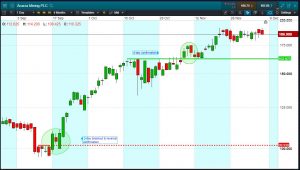This report is not a personal recommendation and does not take into account your personal circumstances or appetite for risk.
The “three day rule” says you should wait this long before contacting a date, so as not to scare them off by appearing over-eager. It’s not dissimilar with trading; how long you should wait before jumping on a share price breakout/bounce or breakdown/reversal.
Waiting helps confirm, or at least increase the probability, that the move is genuine and not just a tease. Prudent when markets are swinging wildly, reacting to presidential tweets, Westminster soundbites, trade war speculation, oil production rumours, monetary policy updates and, of course, daily macro-economic data.
A day can be a long time in trading however. Waiting too long can mean you miss the boat. Jumping on a breakout early may maximise potential profits, but the risk of it being a fake-out is also at its peak. Waiting too long for the breakout to prove itself, however, risks eroding the potential profits. It’s about balancing risk with reward, knowing your appetite for both.
If you hope to make 30% profit you might envisage holding shares for a few weeks. Breakout confirmation of 3 days or 3% might work just fine. For those aiming to make 5% from volatile shares which move up and down 5% in a day might not plan on holding shares for more than a few days.
For scalpers, looking to trade lots of very small moves (e.g. 1%), it may be a case of hours, possibly even minutes. Your date might balk at you calling back the next day, but financial markets aren’t fussy. Because everyone’s trading time-frame is different, in which case everyone’s “three day rule” is different.
To identify yours look at your share price chart. Those trading longer time-frames, using daily charts, will probably find that a 3 day (or 3%) confirmation is just right. Those trading slightly shorter periods, using, for example, 4-hourly candlesticks, may want to wait 12hrs (3 candlesticks; a day and a half). For hourly candlesticks it’d be 3hrs, for 15min candlesticks, 45mins, etc, etc.
It comes down to personal taste but also common sense; depends what you are trading, over what time period and what returns you are after. For each of your trades it may differ. Perhaps two days/hours/mins works for you.
 The goal is to let the breakout prove itself. You want a sign that buyer appetite remains strong, helping keep the shares above the breakout point. You want a greater chance that the move attracts more buying interest that sustains the move, pushing the shares further in the same direction.
The goal is to let the breakout prove itself. You want a sign that buyer appetite remains strong, helping keep the shares above the breakout point. You want a greater chance that the move attracts more buying interest that sustains the move, pushing the shares further in the same direction.
Waiting might feel awkward, but helps avoid being unnecessarily whip-sawed (shares jump up then subsequently fall back). A 3-period confirmation won’t guarantee that all breakouts will hold, but it increases the probability. As much as it’s about profit maximisation, it’s also about risk reduction.
For more of this type of technical commentary on live trading opportunities, get access to our research. We issue trading opportunities on Breakouts daily, along with Support, Momentum, Ranges, Fallers which could help you identify and trade the next best opportunity that presents itself.
Mike van Dulken, Head of Research, 7 Dec 2018
This research is produced by Accendo Markets Limited. Research produced and disseminated by Accendo Markets is classified as non-independent research, and is therefore a marketing communication. This investment research has not been prepared in accordance with legal requirements designed to promote its independence and it is not subject to the prohibition on dealing ahead of the dissemination of investment research. This research does not constitute a personal recommendation or offer to enter into a transaction or an investment, and is produced and distributed for information purposes only.
Accendo Markets considers opinions and information contained within the research to be valid when published, and gives no warranty as to the investments referred to in this material. The income from the investments referred to may go down as well as up, and investors may realise losses on investments. The past performance of a particular investment is not necessarily a guide to its future performance.
Prepared by Michael van Dulken, Head of ResearchComments are closed.